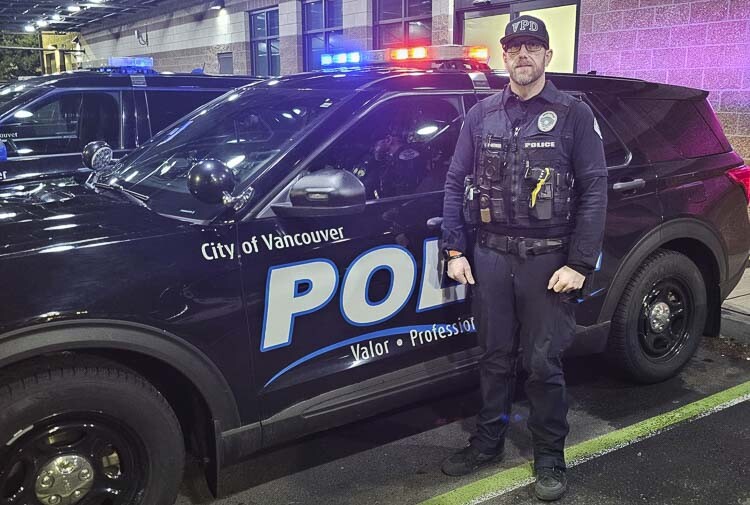
The Target Zero campaign will have emphasis patrols several times a year looking for drivers and passengers who are not wearing seat belts
Paul Valencia
ClarkCountytoday.com
Casey Heinzman likes using Newton to explain the forces in a car crash.
The First Law of Motion says an object in motion stays in motion with the same speed … unless acted up by an unbalanced force.

A traffic officer with the Vancouver Police Department, Heinzman says there are three stages of a crash. The car crash. The human crash. The internal crash.
That is why the use of seat belts is crucial.
“When you’re in a crash, if your car is going 60 miles per hour, your body inside the car is also going 60 miles per hour. When that car stops, if there is not seat belt to hold you in, your body is going to continue forward, causing that human crash inside the car, where you’re slamming against the steering wheel,” Heinzman explained.
Same is true for one’s organs inside the body. They are moving forward, too.
“They do save lives,” Heinzman said of seat belts. “It’s not just something we make you wear. They are proven to save lives.”
Heinzman is working with Target Zero, a statewide campaign with the mission to have zero traffic deaths on Washington roads and highways by 2030.
February’s point of emphasis for Target Zero is seat belt use.
The data tells us that 94 percent of Clark County residents do wear seat belts. That’s a solid number.
“That’s not 100 percent,” Heinzman warned.
In his six years with VPD, he has seen the aftermath of a number of crashes. He has talked to people who have walked away from crashes, knowing that the seat belt saved their lives.
Unfortunately for Heinzman, he has witnessed the opposite, as well, investigating fatal crashes that did not have to be fatal.
That is frustrating to all involved — law enforcement, firefighters, EMTs. They see the impact a decision can make.
“If a person would have worn a simple nylon strap around their waist and chest, they could be alive,” he said.
Heinzman, who grew up in nearby Cowlitz County, was a commercial pilot years ago. But he always had a calling to serve in law enforcement.
He earned a degree in criminal justice and worked in the juvenile probation field. At one point, he was a reserve deputy for a sheriff’s office. His wife suggested he go full-time with law enforcement.
Six years ago, he was hired as an officer with VPD.
“I actually like dealing with people. I like going out there and making sure the streets are protected,” Heinzman said.
He also found a niche with traffic patrol, with an emphasis on stopping drivers who are impaired.
“With DUI enforcement, you’re potentially preventing a fatality from happening,” he said.
He added that many people who he has arrested for DUI later thank him. It was the wake-up call that got them to change their ways.
Citations for not wearing a seat belt can help change behaviors, too, the officer said.
“I think people learn more from the citation aspect of it,” he said. “If they get a bunch of warnings, that doesn’t change behavior.”
Target Zero, Heinzman, and other law enforcement officers, want the number of people who use seat belts at 100 percent.
That is why, several times a year, Target Zero has emphasis patrols for seat belt use. An officer in civilian clothing could be at a busy intersection, just looking for those not wearing seat belts. That officer will call ahead to an officer in a patrol vehicle, and a stop is initiated.
“Seat belts are there to save your life, protect you,” Heinzman said. “They need to be worn.”
Also read:
- Letter: ‘We’re going to give them some money and a plane ticket, and then we’re going to work with them’Camas resident Anna Miller supports a new structured self-deportation policy, calling it a balanced approach to immigration and economic needs.
- Pro-Palestinian protesters occupy UW building, 30 arrestedAbout 30 protesters were arrested at the University of Washington after occupying a building and demanding the school cut ties with Boeing.
- Sen. Braun praises UW officials for response to Monday protests, calls for prosecutionsSen. John Braun praised UW officials for their firm response to violent protests tied to the university’s relationship with Boeing.
- Largest parade in Southwest Washington bands together for a better tomorrowThe 59th annual Parade of Bands in Hazel Dell will feature 24 high school bands and more than 120 entries on May 17.
- Don’t leave tax dollars on the table; learn about county’s tax exemption program at May 16 event in WashougalClark County tax exemption specialists will assist seniors and people with disabilities during a May 16 event in Washougal.
- Trades Tuesday is here, hoping to become a trend in area schoolsA new campaign is launching in area schools to inspire students to consider careers in the trades.
- Opinion: What the 2025 legislature tells us about why Washington’s government keeps failingTodd Myers of the Washington Policy Center argues that Washington’s government fails because it resists humility, experimentation, and accountability in its policymaking.












To increase the use of seatbelts is all noble and good.
But since seatbelt compliance is presently 94%, how about focusing more on some of the other biggies such as speeding? Tailgating? Darting in and out of traffic?
Seatbelt compliance affects only those within that one car. Speeding, tailgating, and erratic driving affect multiple cars (and all of their passengers) who are on the road within the proximity of the offending driver.
Sorry, VPD, don’t mean to rain on your parade, but there seems to be a lot worse things than seatbelt usage towards which your efforts should be focused.